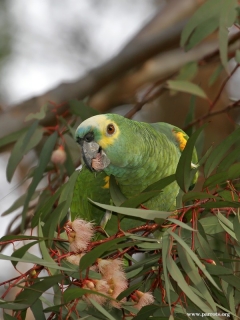Blue-fronted Amazon |
|
|
Also known as: Turquoise-fronted Amazon, Yellow-winged Parrot (A.a. xanthopteryx)
Photos
View in GalleryDid You Know?
Since 1981, nearly 500,000 wild Blue-fronted Amazons have been recorded in international trade.Programs & Projects
WPT has worked with numerous partners to help save this species. Learn moreAcademic Research
Related publications: Amazona aestivaSpecies Profile
Genus: Amazona | Species: aestiva
Size:
35-37 cm (13.6-14.4 in)
Weight:
375-450g (13.1-15.75 oz)(aestiva); 400-500g (14-17.5 oz) (xanthopteryx)
Subspecies including nominate:
two: A.a. aestiva, A.a. xanthopteryx
Colour Adult:
A.a. aestiva: Male-body green, feathers edged soft black; forehead and lores blue; forecrown yellow with or without white; area behind crown, ear coverts to area around eyes, forecheeks and throat yellow; bend of wing red; secondary feathers 1-5 having bases red, the remainder green; tail green with red at base. Bill slate grey. Narrow eye ring white, eye orange, sometimes red. Female-less yellow on face.
A.a. xanthopteryx: Both adults as in aestiva, yellow bend of wing and lesser wing coverts; more yellow on head.
Colour Juvenile:
Immature as in adult but head colour less extensive (some birds with entirely green head) and duller, also less red on wing. Eye dark brown.
Call:
Wide repertoire of whistles, shrieks, yapping help notes; captive birds excellent mimics of human and other sounds.
Listen NowVideo Links:
Video 1More Information:
Content Sources:
CITES
BirdLife International
Cornell Lab of Ornithology/Birds of the World
A Guide to Parrots of the World, Juniper and Parr, 1998
ML Media Collection Catalogue 103200, Blue-fronted Parrot Amazona aestiva, Medler, Matthew, Mato Grosso, Brazil, Jun. 6 2001, Cornell Lab of Ornithology Site
Parrots of the World, Forshaw and Cooper, 1977, 1989. 2010 edition
Parrots of the World, Forshaw, 2006.
Parrots in Aviculture, Low, 1992.
Avian Pediatric Seminar Proceedings, various authors, Jan. 1988.
Photos
View in GalleryDid You Know?
Since 1981, nearly 500,000 wild Blue-fronted Amazons have been recorded in international trade.Programs & Projects
WPT has worked with numerous partners to help save this species. Learn moreAcademic Research
Related publications: Amazona aestivaSpecies Care
Captive Status:
Fairly common.
Longevity:
50-60 yrs
Housing:
Aviary or suspended cage, minimum length 3m (9.84 ft).
Diet:
Fruit such as: apple, pear, orange, banana, cactus fruits, pomegranate, forming about 30% of the diet; fresh vegetables such as: carrot, celery, green peas, beans, fresh corn, green leaves; spray millet and limited mixed seed, cooked/sprouted beans and pulses; complete kibble.
Enrichment:
Bathing; foot toys, destructible (non-toxic) toys, non-destructible (non-toxic plastic) toys, food-finder toys, preening toys, different texture and size hanging perch toys, fir branches, push-and-pull toys (sliding up and down), vegetable tanned leather toys.
Nest Box Size:
12" x 12" x 24" (30.5cm x 30.5cm x 61cm) vertical box.
Clutch Size:
3 to 4
Incubation Time:
28 days
Fledging Age:
8-9 weeks
Hatch Weight:
12-17g (0.4-0.6 oz)
Peak Weight:
376-470g (13.2-16.5 oz) (aestiva)
Weaning Weight:
314-350g(11-12.25 oz) (aestiva)
Photos
View in GalleryDid You Know?
Since 1981, nearly 500,000 wild Blue-fronted Amazons have been recorded in international trade.Programs & Projects
WPT has worked with numerous partners to help save this species. Learn moreAcademic Research
Related publications: Amazona aestivaSpecies Wild Status
World Population:
As low as 1,000,000 and decreasing.
IUCN Red List Status:
Near Threatened
CITES Listing:
Appendix II
Threat Summary:
Trapped in large numbers for wild bird trade; exports rose from over 10,000 in 1981 to nearly 60,000 in 1988, numbers which declined after. Argentina exported almost 245,000 from 1985-1990. Cutting of mature Schinopsis trees, overgrazing by domestic livestock and oil exploration activities are all affecting parts of the Chaco in Argentina, although reasonably large tracts of land remain.
Range:
A.a. aestiva: Inland E Brazil, from Pernambuco and southern Para to W Sao Paulo and S Mato Grosso.
A.a.xanthopteryx: S Mato Grosso and formerly W Rio Grande do Sul, Brazil, N and E Bolivia, and Paraguay to N Argentina; intergrades with aestiva in north western Paraguay, S Mato Grosso, and NE Argentina.
Habitat:
Found in range of wooded habitats and open country with trees. Up to 1600m (5248 ft) in E Bolivia.
Wild Diet:
Feeds on Melia, Aspidosperma, Prosopis, Schinopsis and Ziziphus fruits, and seeds of Citrus, Anadenanthera, Bulnesia and Cercidium; also cactus fruit and palm seeds. Also Erythrina and Morus flowers.
Ecology and Behaviour:
Seen in communal roosts; found in pairs or flocks of several dozen birds. Sometimes seen quite close to human habitation.
Clutch and Egg Size:
3 to 4 ovate eggs, 38 x 30mm (1.5 x 1.2 in)
Breeding Season:
October-March; nest is in tree cavity generally around 9m up or, more rarely, cliff face or arboreal termitarium.
Related Links:
Research: Genetic variability in three Amazon parrot species
Photos
View in GalleryDid You Know?
Since 1981, nearly 500,000 wild Blue-fronted Amazons have been recorded in international trade.Programs & Projects
WPT has worked with numerous partners to help save this species. Learn moreAcademic Research
Related publications: Amazona aestivaMembers Only Resources
Please log-in now to find more research, resources and tools.
Not a Member?
Find more great information:
Gain exclusive access to 600+ pages of additional research, seminars and podcasts, specialists to ask your toughest questions, and dozens of other fun resources - when you become a WPT member.
Join Today >>

































